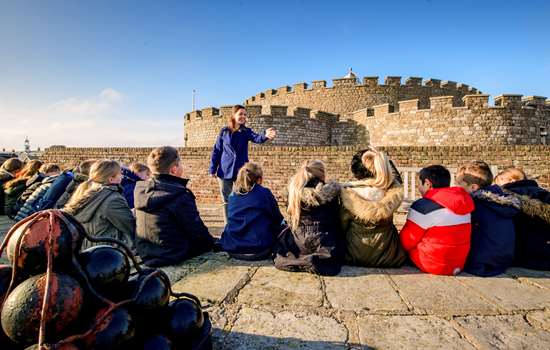Curriculum links
Visit Yarmouth Castle to support your teaching in a fun and engaging way, and cover multiple topics across the curriculum.
- KS1 History: Significant historical events, people and places in the locality
- KS1 English and Drama: To speak clearly, fluently and confidently to different people. To listen, understand and respond to others
- KS2 History: A local history study. A study of an aspect or theme in British history that extends pupils' chronological knowledge beyond 1066
- KS2 Geography: Human geography: types of settlement and land use, identify the manmade defensive features of the site
- KS3 History: A local history study. The development of Church, state and society in Britain 1509–1745. Ideas, political power, industry and empire in Britain 1745–1901. Challenges for Britain, Europe and the wider world 1901 to the present day
- KS3 Geography: Understand the key processes in human geography; understand how human and physical processes interact to influence and change landscapes
Free self-led visits
Book a free self-led visit, and organise your day to suit your curriculum needs. Explore the castle at your own pace, spot the model canon and step inside the rooms to discover how they were used in the 16th century. Visit the exhibition to learn about how and why Yarmouth Castle was built and about the many shipwrecks that occurred in the sea overlooked by it: a perfect theme for a creative project back in the classroom. Dress up in costumes and use our handling collection to discover more about life in the Tudor period. Outside, look out over views of the harbour, and imagine how different the scene might have looked in the time of Henry VIII when the castle was first built.
Find out morePlan Your Trip
We have a wide range of materials to support your visit and make school trip planning easy. You can find all our site-specific information and tools below, and further information on our what to expect page.
Download our free resources to help you make the most out of your visit and create unique learning experiences before, during and after your trip. We also offer free planning visits once you have made a booking, plus a 20% discount on the official English Heritage guidebook for your place of choice.
Once you book your visit you’ll be sent a visit permit, which you’ll need to bring with you on the day.
Visit our bookings page to start planning your trip!
-

Teaching Tudors and Stuarts
This guide to teaching Tudors and Stuarts includes advice from our educational experts and historians as well as suggested activities to try with your students in the classroom or on a school trip.
-
A Mini Guide to Castles
Discover how castles developed over time with this short introduction.
-
Enquire now
0370 333 1181
-
Visit our bookings page to start your enquiry. All bookings must be made at least 14 days in advance. Please make sure you check our terms and conditions ahead of your visit.
If you’d like more information about a site or one of our workshops, get in touch using the online form on our bookings page to speak to your local Education Visits Officer. We look forward to seeing you soon.
